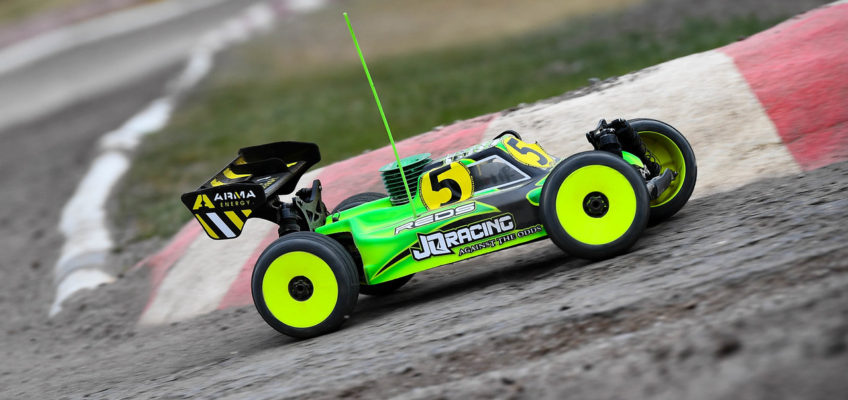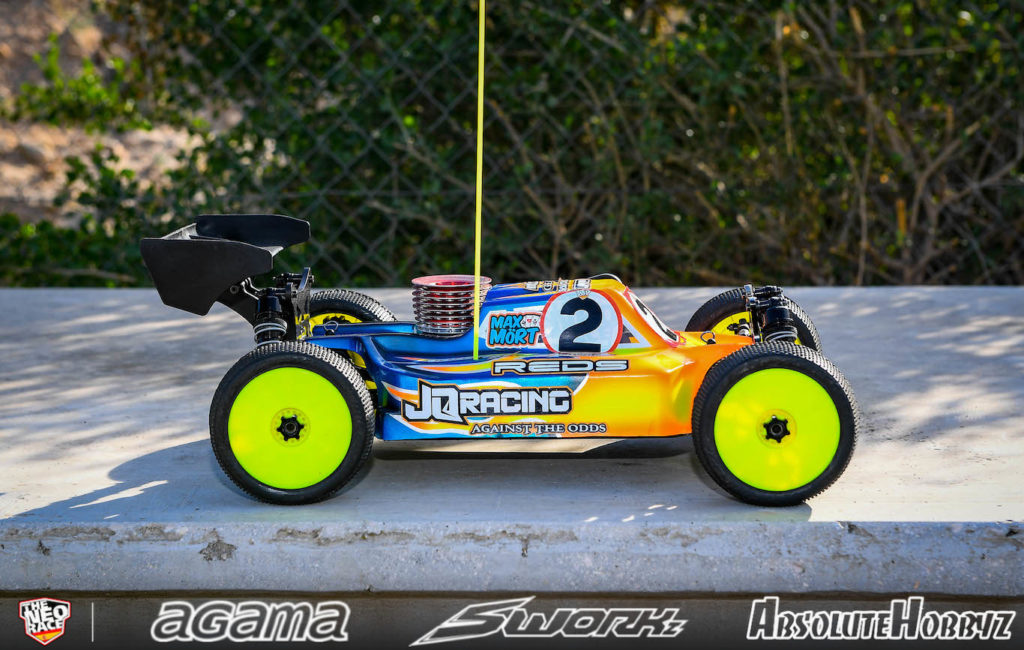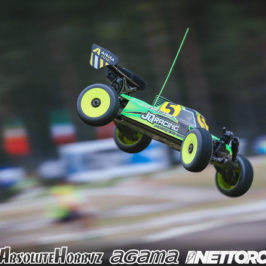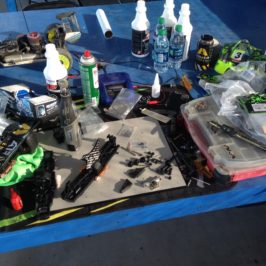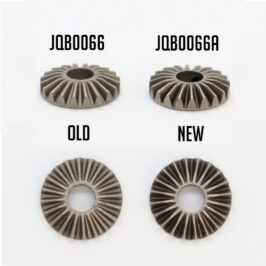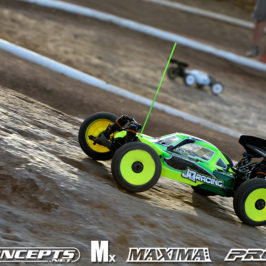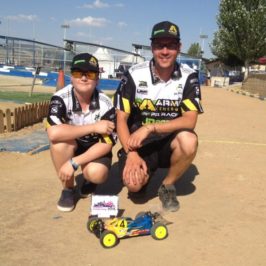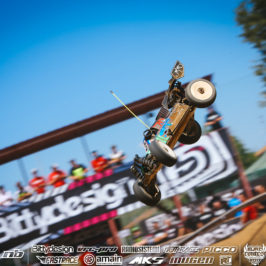For the past 6 months or more, the JQRacing Factory team have all been running the same setups, from track to track, and have ended up with two different versions, depending on track conditions. The starting set up is good in all situations, and is the setup that most drivers start with, and it will be what they end up running on your average track. So any low to medium grip track, smooth to slightly bumpy, big or small, this starting setup will be good. You can find the setup here:
BLACK Edition Starting Setup June 2018
On this setup, the following settings are the ones that are typically changed. There is no need to make drastic changes to this setup, follow the guidelines below.
- Camber: Do not overlook camber. If the rear end of the car is suddenly losing traction, it could be solved by reducing rear camber. If the front end seems darty, it could be solved by either reducing or increasing camber. Drive the track, and have someone adjust front and rear camber until you find the best setting. It can really make a HUGE difference. You won’t believe it if you don’t try it!.
- Swaybars: The swaybars are really important on THECar. The starting setup uses 2.3 front, 2.6 rear. The kit setup has a 2.5 rear which gives more grip, but you can’t drive the car as aggressively on power. The harder rear swaybar makes the car perform better on power. Depending on how the car feels on the track, and what is needed, the swaybars will be changed. For the front we use 2.3 as standard, never really go thicker than that because it makes the front end nervous, but do go thinner to 2.2 or 2.1 for more off power steering. On the rear, 2.6 is used most of the time, but if the rear end needs more support, we go to a 2.8 in the rear. If the car feels stiff on a loose, specially low speed track, then we might go to a 2.5 in the rear for added grip, roll and rotation in corners. The rear swaybar is not so much about traction level of the track, but more about the support needed. Even a loose track with sections where you need to be on the throttle hard while cornering, can benefit from a thicker rear swaybar.
- Springs: We start with the JQ Grey springs, and change if we can see and feel that the car is moving too much on the track. If it is diving, compressing, rolling and squatting excessively, we switch to the HB Yellow front, and Yellow rear springs. This will keep the car more flat, and increase corner speed. Finally, if the car feels nervous, we can go to the Mugen springs, which make the car feel more lazy and calm. We run the 70/9.0 front with 1.5 coils cut off, and 86/10.75 rear. The Mugen springs can really be used in any condition, but sometimes it feels good but makes the car slow.
- Diff Oils: In the front we use 10-15k, thinner for more off power steering, thicker for less. Centre we run 10-20k, basically always as thick as we can get a way with. Start thick, and go thinner until the rear doesn’t want to step out when getting on the gas hard. For the rear, we run 4-15k. The most common oil is 4-5k. That is always safe. For open layouts, where corner speeds are high, and specially if it is high grip, then you can even go up to 15k in the rear! It makes the car very safe entering and going through corners, and it will have a lot of forward drive. To try and generalise all diffs together, typically thick diffs are more stable and easier to drive off power, but can be harder to drive on power. On the other hand, typically thin diffs are more nervous and loose off power, and easier to drive on power. An exception would be high grip tracks, where thin diffs are harder to drive on power also, in those cases thicker diffs are better on and off power, up to a point.
- Anti Squat: Start with 2, and reduce to 1 degree to handle bumps better, or gain traction.
- Toe in: 2.75-3.25 toe in depending on the feel on the track. More toe in for more grip. We usually start with +1 toe in, in the hubs. We take it out if there is enough grip, for more rotation and corner speed.
- Arm Height: The arm height is marked as the lowest setting front and rear. This setting is not completely confirmed, but basically, lower arm generates more grip, and roll, so more steering with a lower front arm, and more rear grip with a lower rear arm. A higher front arm can make the car smoother to drive if it feels twitchy, and a higher rear arm can increase corner speed and rear support when getting on the gas hard.
The above settings are the things we change to dial the starting set up in to most tracks. Then there are some more extreme track conditions where we need to make a combination of changes to improve the handling greatly. For this we run a different base setup, and then largely work with the same exact basic changes above, to dial in the car. You can find that setup here:
BLACK Edition Starting Setup – Edgy High Grip Track – June 2018
- We move the rear hub one step back, to 2 shims in front, and two shims behind. This helps specially driving through bumps.
- We raise the hub, and go from the top hole (lowest hub) to the middle hole insert. This helps reduce side bite, and risk of the rear end catching bumps.
- We then raise the rear link on the inside to compensate for the hub change, to keep a low roll centre. Make sure you are running lower outer on the hub.
- The above changes are all made together, that is how they work the best!
- Hexes: We remove the +1 hexes to reduce side bite, and smooth out the cornering. This is a good change, try it!
- C-Hub: We run the 20 degree C-hubs, as they smooth out the front end and makes the car less nervous on a difficult track.
- Pistons: We try the 6×1.4 pistons front and rear, which normally handle the bumps better and calm the car down. (6×1.3 front haven’t been tested conclusively yet.)
This is really all you need to make the BLACK Edition handle great on any track. Remember, you do not have to make big changes! Below I have added a couple of notes regarding other things we change and experiment with.
- KPI: We start with the 0 KPI now, as it makes for smoother more linear steering. If the track is very consistent, and we want to make the car smooth and easy going in, but then have more steering mid to exit, we run the KPI#1.
- Front Shock Position: We have had some success running the front shock in the outer hole on the arm. It makes the front end more responsive, making it possible to enter corners faster, and still be able to throw the car in the corner and have enough steering, and then in the corner the shock offers the front end more support, so the car doesn’t want to dive as much. To do this, we use the HB Racing long shock end. As the HB shock shaft is 4mm, and ours is 3.5mm, it is good to glue the shock end on. You then have to use a different spring cup, Mugen is a good one because it is low, and you can still achieve a low enough ride height. The shock length you need to achieve is 106.5mm


